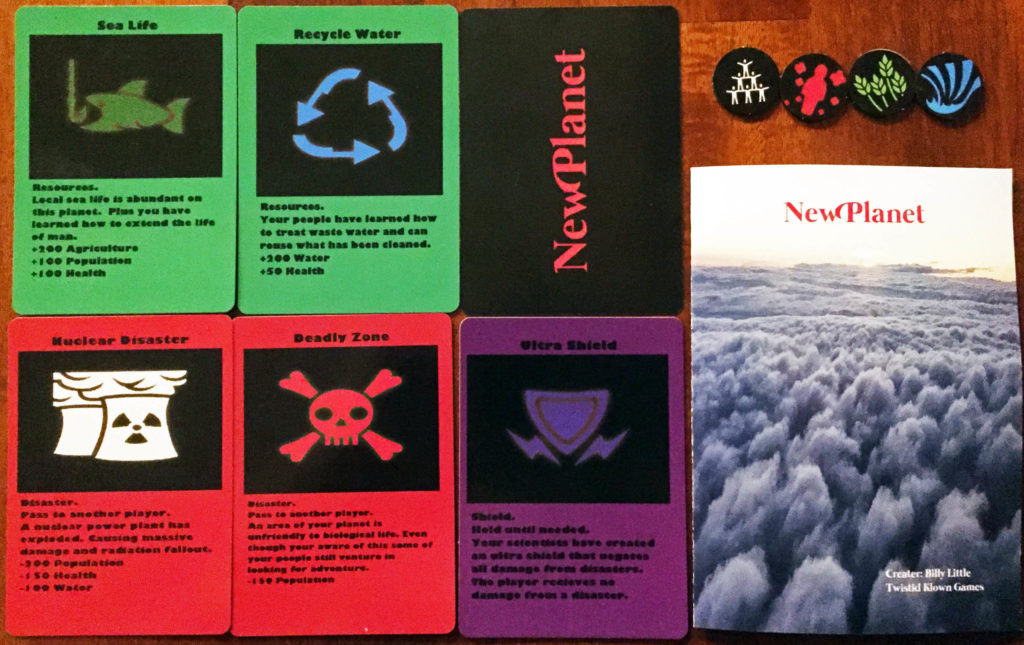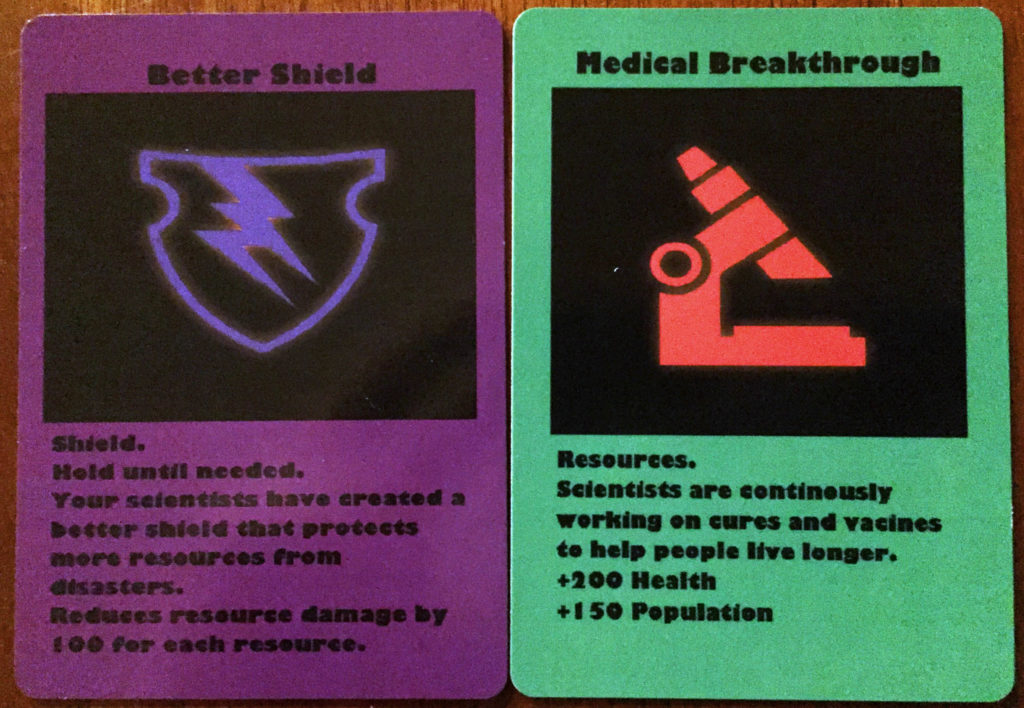“Mille Bornes” was one of the first card games that I truly remember playing as a kid. Its premise was simple too…travel a set distance to win the game. “New Planet” by Twistid Klown Games is somewhat similar in that regard, though you’ll be trying to successfully grow a civilization instead. It supports 2-10 players, is for ages 12+, and has an average play time of about 30-60 minutes. I’ve been told that there may be changes to the artwork so what you’re looking at here may or may not be subject to change. As such, this article will follow my usual “previews” format as it wouldn’t be fair to score a game that is not yet finished. It’s important to note per FCC regulations that this preview is sponsored and that I was paid to cover this game, however my opinions are my own.

The game includes 152 cards, 180 tokens, and a rulebook. The rulebook is available on the game’s Game Crafter page should you want to download or view it for yourself. The components are laser-cut and it is recommended that you wipe them before punching them out, otherwise you’ll end up with soot all over your fingers. Those who know me will no doubt be grabbing a bag of popcorn as I passionately dislike laser-cut components for that reason. That’s a bone that I will choose to pick later on in this article.
The goal of “New Planet” is to be the first player to reach 600 population, 500 health, 500 agriculture, and 500 water. These resources are tracked via the game’s tokens. Small tokens are worth 50 while large tokens are worth 100. Players draw/discard these tokens as they earn/lose them via cards, respectively.
Speaking of cards, there are three types: 1) Resource, 2) Disaster, and 3) Shield. Resource cards help players earn the resources they need to reach victory. Some resource cards have negative effects as well and you must actually be in possession of the resources you’d lose before the card can be played. Disaster cards, for the most part, cause players to lose resources and for obvious reasons, you’d want to play these on your opponents whenever possible. A few disaster cards must be played immediately and are labeled as such. Shield cards block disaster cards.
At the beginning of the game each player starts with a hand of five cards. The player to the dealer’s left goes first. For every player’s first turn, they’ll play one resource card, earn the appropriate resource, and pass to the next player. In future rounds, they’ll draw a card first from the deck before playing a card. If a player draws a disaster card that must be played immediately, players will resolve its effects and the active player gets to take another card from the deck. Players continue taking turns until the victory condition has been reached.
Editor’s Note: The above doesn’t cover all of the rules found in the manual but should give you a general idea as to how the game is played.

This game is a prime example as to why I do not “review” games that aren’t yet finished. Had I given this game an actual score…well, it wouldn’t have been favorable. That said, the game IS retailing for $39.99 on The Game Crafter making it somewhat fair game for criticism. As such, there really should be a note to any potential customer that the game is not yet complete. In other words, you’re buying a prototype as of the date of this posting. Finished copies of games are typically…well, finished. If a customer can purchase a copy of a game with one kind of art style now and then can purchase the game again six months later to receive something different, then it’s not finished.
Onto the subject of laser-cut components. It is my opinion that if you’re going to pay $40 for a game there should be no issues with the components. Components of a $40 game should be finished in such a way to where very little maintenance is required to pop them out of their boards (I.E. “Splendor”). I blasted Victory Point Games for similar practices six years ago and they’ve since began selling “premium” versions of their bagged laser-cut component games. I can’t be the only consumer to be annoyed with having to clean components, boxes, tables, and hands of soot after spending money on a game.
Let me make one thing clear. I don’t say these things to discourage first-time developers from coming up with ideas and bringing them to life for other people. The joy of introducing new games to other enthusiasts is WHY I do what I do. “New Planet” is a good start. With more time and work, I have no doubt that it could be competitive in the current market. At present, the price is too high to justify anyone picking up a game that is not yet complete. Assuming it were finished now as-is, it still wouldn’t be worth it. Anyone who is familiar with the plethora of quality Kickstarter gaming projects out there will know what I’m talking about.
The game needs a cheaper price point. I’ve covered MANY games sold through The Game Crafter and developers tell me the same thing every time: I had to price it that high to break even with production costs. Costs are higher because the developer wasn’t bulk ordering them from a standard publisher/manufacturer. That’s fine. A paying consumer however doesn’t care about that. They’ll look at a game like “Splendor” or “Power Grid” and compare it to something else of lesser quality that costs more and think, “why would I pay more for less?” I’d honestly recommend crowdfunding to bring the art and components up to speed.
Gameplay is functional with a mix of both luck and strategy. This is a resource collection/juggling game and it can be frustrating to not draw what you need. There’s also a “take-that” element in the sense that you can ruin someone else’s day by playing a disaster card on them. While not in the manual, parents with competitive kids who argue a lot could remove the disaster cards altogether to mitigate the fighting or the possibility that two kids could gang up on a third. By going that route shield cards wouldn’t be necessary and players would simply focus on generating resources. To mitigate being stuck because of bad draws/ luck, I’d recommend adding some kind of trading element to the game that could be observed right before a player’s play a card step of their turn.
“New Planet” has potential. It gives casual gamers access to a genre that is usually fairly complex…owners of games from the “Civilization” series for the PC will know what I’m talking about. When it comes to younger players, it easily introduces the idea of juggling multiple resources instead of just adding up more victory points. Over time, “New Planet” could really become something and I’d love to see this game grow all-around. The art and the quality if the components as it stands now just aren’t up to snuff. The text is difficult to read with the current color schemes. If nothing does change or remains roughly the same artistically and structurally, then it would need to come down in price to remain competitive with other card games on the market ($15-25).
Everyone has a different comfort zone when it comes to buying games. In fact, I know a LOT of people who don’t mind paying extra to chip in and help support the developer…heck, look at Steam’s Early Access program and games like “Star Citizen”. If $40 is within your comfort zone for a game like this, then by all means don’t let me discourage you. The world needs more entry-level Civ-style games in my opinion.
Buy: https://www.thegamecrafter.com/games/new-planet
—
